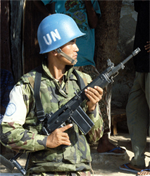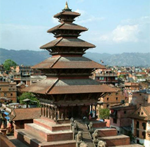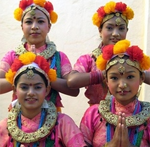Nepal has a rich geography. The mountainous north has eight of the world's ten tallest mountains, including the highest point on Earth, Mount Everest, called Sagarmatha in Nepali. It contains more than 240 peaks over 20,000 ft (6,096 m) above sea level.[7] The fertile and humid south is heavily urbanized.

Nepal's military consists of the Nepalese Army, which includes the Nepalese Army Air Service (the air force unit under it.) Nepalese Police Force is the civilian police and the Armed Police Force Nepal[44] is the paramilitary force. Service is voluntary and the minimum age for enlistment is 18 years. Nepal spends $99.2 million (2004) on its military—1.5% of its GDP. Much of the equipment and arms are imported from India. Consequently, the US provided M16s M4s and other Colt weapons to combat communist (Maoist) insurgents. As of now, the standard-issue battle rifle of the Nepalese army is the Colt M16.
Nepal has close ties with both of its neighbours, India and China. In accordance with a long-standing treaty, Indian and Nepalese citizens may travel to each others' countries without a passport or visa.

Nepal's diverse linguistic heritage evolved from four major language groups: Indo-Aryan, Tibeto-Burman, Mongolian and various indigenous language isolates. The major languages of Nepal (percent spoken as mother tongue) are Nepali (49%), Maithili (12%), Bhojpuri (8%), Tharu (6%), Tamang (5%), Newari/Nepal Bhasa (3.6%), Magar (3.4%), Rai (2.8%), Awadhi (2.5%), Limbu (1.5%), and Bajjika (1%).
Derived from Sanskrit, Nepali has roots in Sanskrit and is written in Devanagari script. Nepali is the official national language and serves as lingua franca among Nepalis of different ethnolinguistic groups. Regional dialects Awadhi, Bhojpuri, Maithili and rarely Hindi are spoken in the southern Terai Region.

A typical Nepalese meal is dal-bhat-tarkari. Dal is a spicy lentil soup, served over bhat (boiled rice), served with tarkari (curried vegetables) together with achar (pickles) or chutni (spicy condiment made from fresh ingredients). The Newar community, however, has its own unique cuisine. It consists of non-vegetarian as well as vegetarian items served with alcoholic and non-alcoholic beverages. Mustard oil is the cooking medium and a host of spices, such as cumin, coriander, black peppers, sesame seeds, turmeric, garlic, ginger, methi (fenugreek), bay leaves, cloves, cinnamon, pepper, chillies, mustard seeds, etc., are used in the cooking. The cuisine served on festivals is generally the best.
Chitragupta Tours Pvt. Ltd
SH-8/3-A-I-K,
Shivpur Bypass
Behind Lord Budha Public School.
Shivpur, Varanasi-221003, (UP)-INDIA
![]() +91-9936188440, +91-9140245699
+91-9936188440, +91-9140245699
+91-9936188441
![]() info@chitraguptatours.in,
info@chitraguptatours.in,
![]() www.chitraguptatours.in
www.chitraguptatours.in